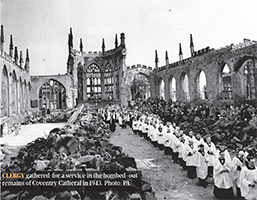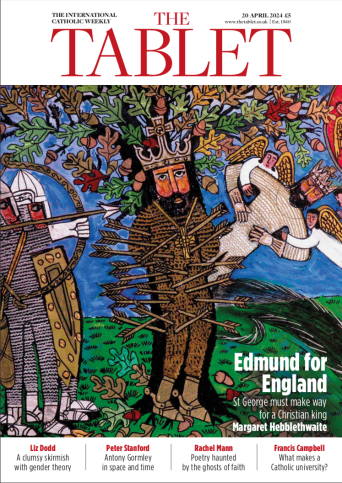Seventy years on, it may be hard to imagine the Second World War as a religious conflict. Yet at the time it was defined as the ultimate struggle for the Church’s survival
Wednesday 2 September will mark the seventieth anniversary of the formal surrender of Japan, and with it the end of the most destructive war in history. The Second World War resulted in the deaths of more than 55 million people, most of them civilians; it triggered the Holocaust, laid waste vast swathes of Europe and Asia, and saw the advent of nuclear weapons.
But for all its significance it remains poorly understood, not least in Great Britain. Here, perceptions of the conflict are largely governed by a complacent national mythology that still has an unsettling resonance among English football fans (“Where were you in World War Two?”, as Chelsea fans chanted on the Paris Metro last February).
From a British perspective, the war in Europe began on 3 September 1939, when Britain declared war on Germany, and its end was marked by VE Day, 8 May 1945. Japan entered the war with its attack on Pearl Harbor on 7 December 1941, accompanied by assaults on British possessions in the Far East, and surrendered after the dropping of atomic bombs on Hiroshima and Nagasaki in August 1945. In its six-year course, the war saw its low points (Dunkirk, the surrender of Singapore, Arnhem, among others), together with its highs (the Battle of Britain, El Alamein, D-Day, to name a few).
As a national epic, the narrative is very satisfying: it has a redemptive quality (the Empire came good after all), and it has a striking chronological balance (“Before Alamein [in 1942] we never had a victory; after Alamein, we never had a defeat,” as Winston Churchill claimed, quite erroneously). All this makes no sense beyond our islands’ shores. Try telling a Pole that the war in Europe began on 3 September 1939, or a Chinese that Japanese aggression started in 1941.
A constant theme in British perceptions of the war is an emphasis on the spiritual: “the Dunkirk spirit” or “the spirit of the Blitz”. However, a critical element of that spirit has been neatly excised from our collective memory – the role of religion and, more specifically, of Christianity. This amnesia reflects the rapid de-Christianisation of British society since the 1960s, with the collusion of the British Churches themselves, eager to draw a veil over a more militant past.
The failure to recognise the extent to which the conflict was a religious war helps to account for the widespread incomprehension of religiously sanctioned violence, especially that of a radical Islamist variety. True, British servicemen in the Second World War did not seek self-immolation for religious reasons, and civilians rarely saw the war in exclusively religious terms, but Nazi Germany was seen as an existential threat to Christendom as well as to the British Empire, and the rhetoric and conduct of the war was strongly coloured by this conviction.
Take Churchill’s “finest hour” speech of 18 June 1940. What, above all, were the British people summoned to defend in order to safeguard the future of the world? “Christian civilisation” – a mission that seemed to enjoy a divine mandate in light of the recent, and seemingly miraculous, evacuation from Dunkirk. Nor was it just the stilling of the Channel waters for the evacuation (whose turbulence, even in June, caused D-Day to be postponed four years later) that sustained this conviction.
The subsequent blitz of British cities saw the most sustained devastation of Britain’s ecclesiastical infrastructure since the civil wars of the seventeenth century. This included the destruction of Coventry Cathedral, and the remarkable survival of St Paul’s, whose preservation amid a hellish sea of flame formed the subject of one of the most famous – and symbolic – photographs of the war. From 1942 to 1945, the Ministry of Information published Spiritual Issues of the War, a weekly magazine that highlighted issues such as the Nazi euthanasia programme and the persecution of Christianity in Germany and occupied Europe.
A succession of 11 national days of prayer, called at the behest of King George VI, proved remarkably popular throughout the war, the success of the Dunkirk evacuation even being ascribed to that held on 26 May 1940.
In 1942, like Sir Douglas Haig prior to the Battle of the Somme a generation earlier, Bernard Law Montgomery (the son of an Anglican bishop, brother of an army chaplain, and morale-booster extraordinaire) helped to prime his troops for victory at El Alamein by stressing the role of their chaplains, leading him to claim later that “I would as soon think of going fighting without my artillery as without my chaplains”.
D-Day, a Tuesday, was marked by spontaneous recourse to opened churches for prayer services, while VE Day and VJ Day saw hugely well-attended services of thanksgiving – 35,000 people attended St Paul’s Cathedral on VE Day alone. The strength of this religious impulse was reflected in army figures for religious affiliation, with less than 1 per cent of soldiers being recorded as atheists in 1942.
The religious practice of prisoners-of-war in appalling conditions in the Far East served not only as a source of personal consolation, but also as a mark of defiance against their Japanese captors. Similarly, the less straitened circumstances at home proved to be fertile soil for a Christian cultural revival. This was marked in literature by the work of T. S. Eliot, Dorothy L. Sayers and C. S. Lewis, and in the 1944 Education Act, which required “religious instruction” and a daily act of worship in all publicly funded schools.
This wartime piety had a retributive and even rebarbative edge. The insignia of the crusader’s cross – conspicuously absent in the British Army during the First World War – was flaunted by the British Army in North Africa, Italy and north-west Europe. Three centuries after the victory of the “godly party” in the 1640s, one MP could write: “I am Cromwellian – I believe in ‘slaying in the name of the Lord’, because I do not believe you will ever bring home to the civil population of Germany the horrors of war until they have been tested in this way.”
For some, the mood and rhetoric of militant Christianity seems to have sanctioned an appetite for vengeance on a biblical scale, manifested most controversially in the obliteration bombing of German cities from 1942. When “Bomber” Harris declared that Nazi Germany had sown the wind and would now “reap the whirlwind”, he was quoting from Hosea 8:7. Bomber Command’s sustained attack on Hamburg in the summer of 1943, which saw the use of incendiary bombs on an unprecedented scale, was grimly codenamed “Operation Gomorrah”. It scarcely seems an accidental irony that the effects of the RAF’s apocalyptic visitation of Dresden 18 months later were revealed in the fiery half-light of Ash Wednesday 1945.
Was this a narcissistic narrative of national self-righteousness, the recrudescence of a centuries-old self-image of Protestant Britain as an elect nation? Possibly, but this was by no means the whole story. Britain’s self-image as the champion of Christendom was at least partly derived from the perceptions of sympathetic outsiders.
In 1941, for example, the Swiss theologian Karl Barth declared in his Letter to Great Britain that “the obedience of the Christian to the clear will of God compels him to support this war”, and even a Free French spokesman described Britain as the custodian of “the conscience, the mission, the last hopes of Europe”.
More significantly, the strongest card the US Roosevelt administration could play in support of aid to Britain in 1940-41 was an appeal to its credentials as a kindred Christian nation assailed by the forces of neo-pagan darkness. When Churchill and Roosevelt met at Placentia Bay in August 1941, they joined in a parade service and, in a hugely symbolic gesture, sang “Onward Christian Soldiers”.
Even Stalin thought it helpful to indulge British sensibilities. The Soviet Union’s relaxation of the repression of religion certainly helped mobilise Russian resistance to the Nazi invasion, but it also encouraged the flow of aid from Britain and the US. Stalin even confided to the British ambassador in Moscow that he, too, believed in God.
Nazi Germany also tried to harness religious energies in support of its war effort, especially against the Soviet Union, but this ran counter to the regime’s marginalisation of the Churches and its long-term goal to de-Christianise Germany.
Significantly, there were no chaplains in the most Nazi-supporting elements of Germany’s armed forces – the Luftwaffe and the SS – and their retention in small numbers by the army and navy was merely a pragmatic sop to tradition in these more conservative institutions.
Whatever the vagaries of popular and ecclesiastical memory in the 70 years since the war ended, the British state and people derived sanction and support from their historic Christian faith for what was perceived as a just and necessary war – and this only 20 years after the trauma of the First World War, which is so widely and wrongly touted as having dealt a terminal blow to such pretensions. When faced today with a link between religion and violence that is often presented as anomalous and atavistic, we should remember on this anniversary that Christianity played a major role, for good or ill, in defining and supporting Britain’s part in a struggle of unparalleled ferocity.
Michael Snape is Michael Ramsey Professor of Anglican Studies at Durham University and author of God and Uncle Sam: Religion and America’s Armed Forces in World War II.





 Loading ...
Loading ...
What do you think?
You can post as a subscriber user...
User Comments (2)
Arthur Hinsley, courageous Yorkshireman and Archbishop of Westminster, did much to stir the nation in those trying years. Churchill famously remarked, when Canterbury became vacant, "It's a pity we couldn't have that man up at Westminster." When Hinsley died, most of the Cabinet attended his funeral - a rare event in those pre-ecumenical times. Neither should be forget the many Catholic servicemen who fought the good fight, from the fire-eating General Sir Adrian Carton de Wiart,VC, DSO, to southern Irishman Lieutenant Commander Eugene Esmonde VC, of the Fleet Air Arm who was killed attempting to halt the "Channel Dash" of the German warships Scharnhorst and Gneisenau. Midget Submariner James Magennis VC, was Northern Ireland's sole VC winner, but his Catholicism was regarded as an affront to "loyalists" . He had attacked the German battleship Tirpitz and sank a Japanese heavy cruiser in Singapore in 1945. He couldn't get a job when he returned to Northern Ireland and the prime minister, Lord Brookeborough, felt unable to attend his civic reception.
Philip Jenkins, in his "The Great and Holy War: How World War I Became A Relgious Crusace" (2014) says essentially the same about the 1914-1918 war.
It seems necessary for religious leaders to bless mass slaughter in order for the many to feel justified in participating in unspeakable activities against their fellow human beings.